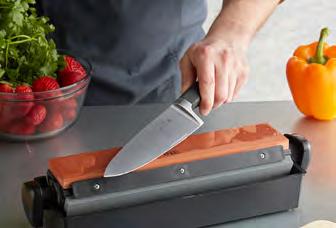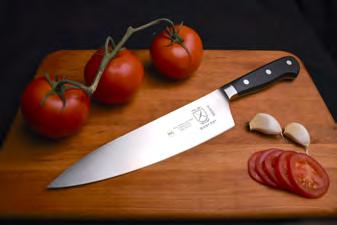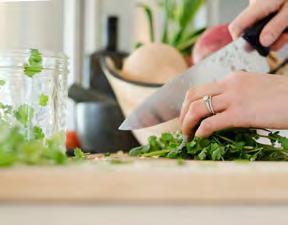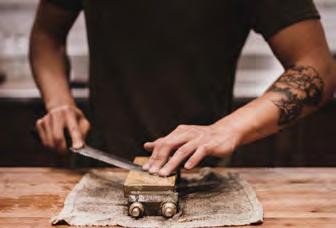
9 minute read
KNIVES OUT THIS SEASON
GIVE YOURSELF AN EDGE FOR CHRISTMAS. A SHARP EDGE.
Matt Freeman
IT’S THE HOLIDAY SEASON. A TIME OF FEASTING AND merriment and so forth.
But some of us, otherwise content and comfortable, don’t anticipate preparing their own feast with any particular joy. That’s because of a surprisingly common privation—we don’t have knives that will cut stuff well.
Too many of us have a drawer full of knives, sharp when purchased, but now woefully dull. With meats, these old implements saw more than slice. And they don’t cut a tomato as much as bludgeon it into submission. Cutting carrots makes a series of loud cracks as that old knife wedges through and whacks the cutting board.
This is a sad story for so many reasons. First of all, having sub-par knives is dangerous. The extra force needed to make dull knives cut can make them go out of control and cut you. Dull knives damage the ingredients. And some believe these unloved things take the joy out of cooking.
The knife is universally acknowledged to be a cook’s most important tool—the “second most important tool in the kitchen, after your hands,” says Andrew Deery, chef/owner of Phoenixville’s popular erstwhile restaurant Majolica.
Yet thousands of avid home cooks suffer with needlessly dull knives and have seemingly resigned to live with the situation.
But it doesn’t have to be this way. It’s easily fixable. If you’ve forgotten how nice it is to use a knife that glides effortlessly through your ingredients, read on.
GIVE YOURSELF AN EDGE
Start with a quality knife. If you need a good, starter kitchen knife, or want to get someone else one, you’re in luck—professionals agree on how to begin. • What kind? The 8-inch chef’s knife is close to a universal recommendation as your main knife. But Chef Deery has some advice here: get a knife that’s proportionate to you. Chef’s knives are found from 6 inches to 10 and up, so get one that’s the right size for you with a handle that feels comfortable. It should also feel balanced and nimble. This is personal, so try a few if possible.
Essentials also include a smaller knife, from a 3-inch to about a 5-inch blade, and maybe a serrated bread knife. • Which brands? You can’t go wrong with the big-name brands you see in kitchenware stores such as Williams-Sonoma and Sur la Table. Zwilling J.A. Henckels (two names, one company, long story) and Wüsthof are the big dogs, and they make fine but somewhat pricey knives. Their classic models typically run from $150 to $180+. But you’ll go home with a very nice knife.



If that seems like too much to pay, you’re not alone. There’s a crowded field of knives with more reasonable prices, slightly less history and tradition, and made not in Germany but Taiwan and other places. Less cachet. Just as good, if from the right outfit.
You can get a handsome, well-made knife that will work every bit as well as the big names for $40 to $50+. The Victorinox Fibrox is a widely popular chef’s knife in this price range. There are also knives from Mercer Culinary, including the more traditional-looking Renaissance line and somewhat updated Genesis. Many culinary-school students get Mercers to use when they’re starting out, so this brand meets that professional standard.
If you’re starting out on your knife quest, it’s safest to stick with proven brands. There are real bargains around if you’ve done some research and know what you want in a knife. (There are sub-$20 knives that work as well as the pricier ones, but are made of softer steel that needs more frequent sharpening.) There are also mediocre knives that won’t cut as well or hold an edge as long. • Tips and caveats. Although trying out the knife is preferable, ordering online gives you many more choices. Online reviews abound and identify the various strengths and weaknesses. Don’t pay much attention to people who insist you get a full-tang knife and that it has to be forged, not stamped. You don’t even need to know what that means. Decades ago it might have meant something, but not now.
If you’re buying for other people—a young person setting up fresh or a retiree getting into cooking—remember it’s personal and consider gift cards or taking them on a knife-buying excursion. You might both come home with a lovely new blade.
• About Japanese knives. Bladesmithing is a centuries-old tradition in Japan, and Japanese knives, typically with harder steels that allow them to be thinner and sharper, are common in professional kitchens. These knives are migrating out to the home-cooking public.
Deery remembers his astonishment at the difference in performance the first time he tried one. “I cut with it, and it was a revelation,” he says. “It was night and day.”
In a store you’ll likely see Japanese and Japanese-influenced knives for sale. The wildly popular “santoku” shape (straight edge with a narrow sheep’s foot blade) is a good all-rounder, as is the “gyuto,” a Japanese interpretation of the European-style chef’s knife. They’re often quite beautiful, actually.
If you’re intrigued, check them out, but remember a traditional German-style knife is usually made to be a bit tougher, and that’s good to have in your collection, too.
The more you learn about this fascinating part of human history and daily life, the more you’ll know which knives out there are right for you.
THE EASY WAY
Once you have a quality knife, the next lesson is simple—a modicum of maintenance. Professionals do it, home cooks who insist on sharp knives do it, and you can do it, too. It’s easy.
The thing is, however sharp when new, all knives get dull with use. It just happens more slowly with good ones made of a suitable steel. • Honing rod. The first step to better knives is to lengthen the time between sharpenings by using a ceramic (not steel) honing rod




every two or three days or whenever the knife is getting a bit dull. This will straighten out the knife’s edge, make it cut more efficiently again, and does some actual sharpening as well. (Old-school steel honing rods just straighten the edge, not sharpen it.) Ceramic honing rods are easy to use. Check online for instructional videos, and you’ll be good to go. It’s simple, really. • Washing and storing. The only other important day-to-day maintenance needed is to wash the knife by hand and dry it off, then put it away in some sort of dedicated knife holder or with a blade guard at least. Don’t just bung it in a drawer with a lot of other metal stuff banging into it.
And for goodness’ sake, don’t put a good knife in the dishwasher, where banging, heat and chemicals will damage the handle and steel. Just wash it by hand. It won’t take a minute, as in it literally will not take 60 seconds to do. • Cutting boards. You can also preserve that knife’s edge by using a wood (not bamboo) cutting board. Bamboo has abrasive particles in it. Surfaces like granite, marble and glass will kill the edge very quickly. Plastic is OK, if you must, but isn’t wood just nicer? • Professional sharpening. Eventually, though, through use the knife will become noticeably duller and the honing rod won’t bring it back as well. Time to get your knife sharpened.
The easiest way by far is to get your knife sharpened professionally. Sur la Table in King of Prussia will sharpen it professionally and overnight for $5. Same deal at the Williams Sonoma stores in King of Prussia, Christiana and Cherry Hill Malls (but unfortunately, not Glen Mills).
Lots of local people also offer sharpening services. And there’s even an outfit called Knife Aid that will send you a mailer and send back your newly sharpened knives.
Long story short, it’s easy. It’s like going to a dry cleaner. Drop it off, pick it up like new.
OR THE HARDER WAY
If you want, though, you can take care of sharpening yourself.
Let’s look at the options in order of increasing effort involved. You’re already honing, right? Great.
The next step in actual sharpening involves a manual or electric pull-through sharpener.
You’ll get good results with the better models from name brands, prominent among which is the locally born Chef’s Choice. A good manual pull-through model might cost around $40, with electric versions running higher. It’s not the gentlest way to sharpen, and Chef Deery says he hasn’t ever used one, but allows as how they’re “probably better than nothing.”
The next step up, both in quality and ease of use, involves guided sharpening systems. These are tabletop jigs that hold the knife steady and hold abrasive strips at various set angles to it so you can put on a new and, from practiced hands, excellent edge. They start at around $40 or $50.
In what’s called “freehand” sharpening, you mostly use whetstones—rectangular blocks of natural or artificial abrasives—to grind that new edge. Here, you have to learn to hold the knife at a steady angle as you move it across the stone. It takes a bit of muscle memory and some time practicing, but the versatility is far greater, the pride of accomplishment greater too, and if you tend to be a do-it-yourselfer and enjoy learning new stuff, it’s actually kind of fun.
There are hours of online videos demonstrating how it’s done, and the best idea is to check out a few to see if it’s something you’d like to try. You can get an inexpensive starter stone from—where else?—Mercer. You’ll want the 400/1000 grit combo stone. (Just trust us. It’ll all make sense eventually.)
If you decide that’s not for you, no problem. The main thing is to find yourself a good knife or two or three, find some way to maintain them, and then find that cooking is a lot more gratifying than it used to be.
“It’ll vastly improve your food and experience while cooking,” Deery says. Vastly. Improve. We’re just saying. ©












